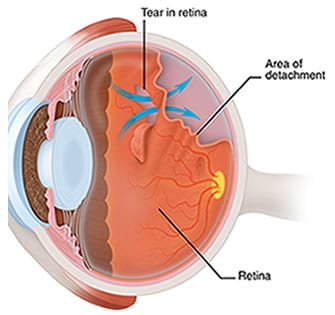Flashes and Floaters (PosteriorVitreousDetachment)
Most flashes and floaters are caused by age related changes in the material that fills the eye (vitreous humor). When young, this material is thick and gelatinous, but with age, the vitreous becomes thinner and clumps and strands of protein can begin to float around in the eye. These clumps and strands may cast a shadow on the retina causing floaters.
After the age of 50, or sometimes earlier in nearsighted people or patients that have had eye surgery or eye injuries, the vitreous becomes more watery and can pull away (posterior vitreous detachment) from the retina causing an increase in floaters, bigger floaters and/or flashing lights. The tugging on the retina from the vitreous contracting causes flashing lights and can cause a retinal hole, tear or retinal detachment.
An increase or change in the size of floaters, the development or persistence of flashing lights or a veil-like blockage of a portion of the vision, require a prompt retinal exam to detect a retinal hole, tear or detachment. Such a development may require immediate treatment to help prevent blindness.
Fortunately, most posterior vitreous detachments do not leak to the development of retinal holes, tears or retinal detachments.
The floaters usually become less noticeable with time and the patient often will adjust and “tune out” the floaters.The floaters cannot be removed with laser, eye drops or oral medication, but occasionally will sink to the bottom part of the eye in time causing a decrease in the perception of floaters. Rarely, if the floaters are extremely debilitating to the patient, then vitrectomy surgery can be undertaken to remove the floaters.
Macular Hole
The most common cause of a macular hole is pulling or traction by the vitreous jelly on the center of the retina in an area called the macula. The traction causes a small retinal hole to develop in the macula along with loss of central vision and visual distortion. Vitrectomy surgery can often be helpful in restoring some of the visual loss caused by the hole.

The surgery involves microscopic removal of the vitreous, release of the traction and filling the eye with an intraocular gas bubble which allows the edges of the macular hole to grow back together.
The bubble slowly dissipates from the eye and can last up to 6-8 weeks. The success of the surgery is absolutely dependent on the patients’ ability to maintain proper face down positioning after surgery for up to two weeks postoperatively. Our retinal surgeons will discuss in detail the positioning requirements and positioning chairs which may assist in positioning. It is imperative that travel in an airplane be avoided until the gas has completely resorbed from the eye, otherwise blindness can result.
If you have not previously had cataract surgery, a cataract will likely develop within a few months of the surgery and the vision may be helped by surgical removal of the cataract.
Macular Pucker
Macular pucker, also known as an epiretinal membrane, is a condition caused by the growth of a transparent membrane on the surface of the macula. This membrane may cause blurry vision and distortion (wavy lines). Epiretinal membrane formation usually progresses slowly and often does not require treatment.

The cause of these membranes is not known, but they do occur more commonly in people with high blood pressure. If the membranes progress to cause significant distortion or visual loss, vitrectomy surgery may be recommended. After the membranes are surgically removed, the normal smooth surface of the retina is restored usually resulting in vision improvement and resolution of much, if not all, of the distortion.
Retinal Tear and Detachment

After the age of 50, or sometimes earlier in nearsighted people and in persons who have had eye surgery or eye trauma, the vitreous becomes more watery and can pull away from the retina causing an increase in floaters or flashing lights. This condition is known as a posterior vitreous detachment or PVD. Retinal tears occur when a PVD leads to pulling followed by tearing of the retina. The tear may then allow fluid to go through the tear and under the retina causing a retinal detachment.
The tugging on the retina from the vitreous contracting causes flashing lights. An increase or change in the size of the floaters or the development or persistence of flashing lights or the veil-like blockage of a portion of the vision requires a prompt retinal exam to detect a retinal hole, tear or detachment which may then require immediate treatment to prevent blindness.
Retinal tears are treated with laser or freezing (cryotherapy) therapy in the office. Retinal detachments are treated with vitrectomy surgery, scleral buckle surgery or pneumatic retinopexy usually as outpatient surgery in our on-site surgical center.

